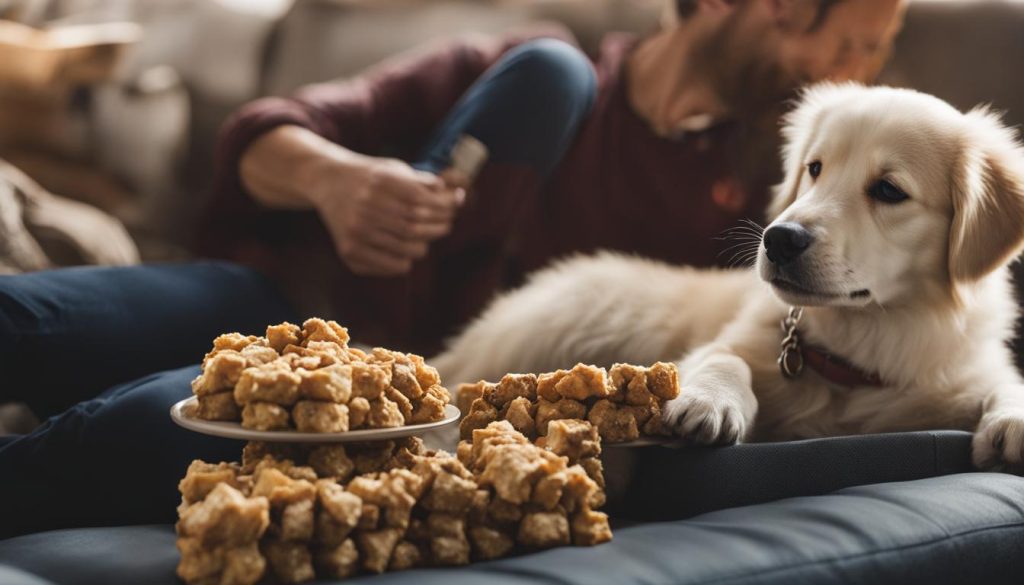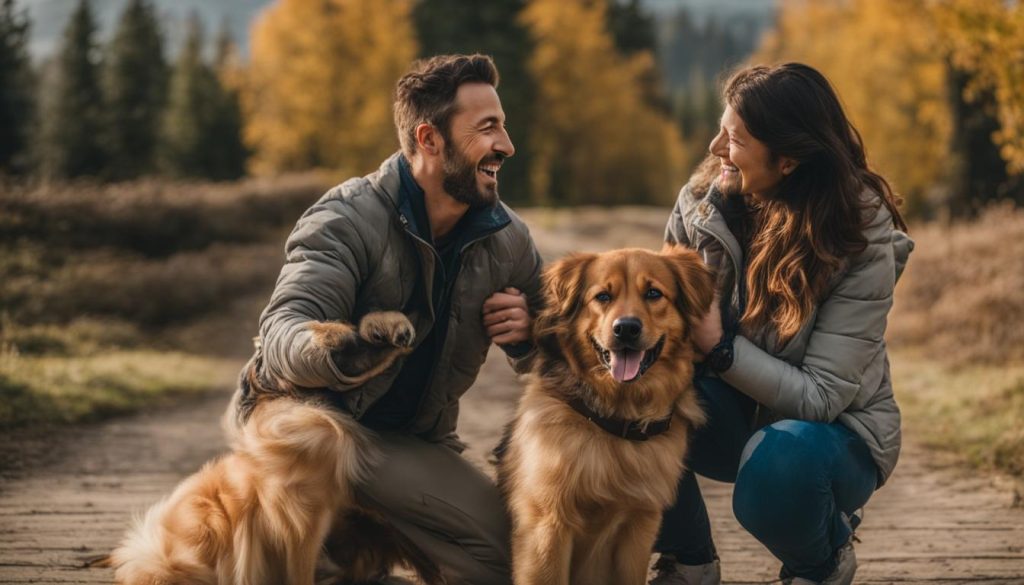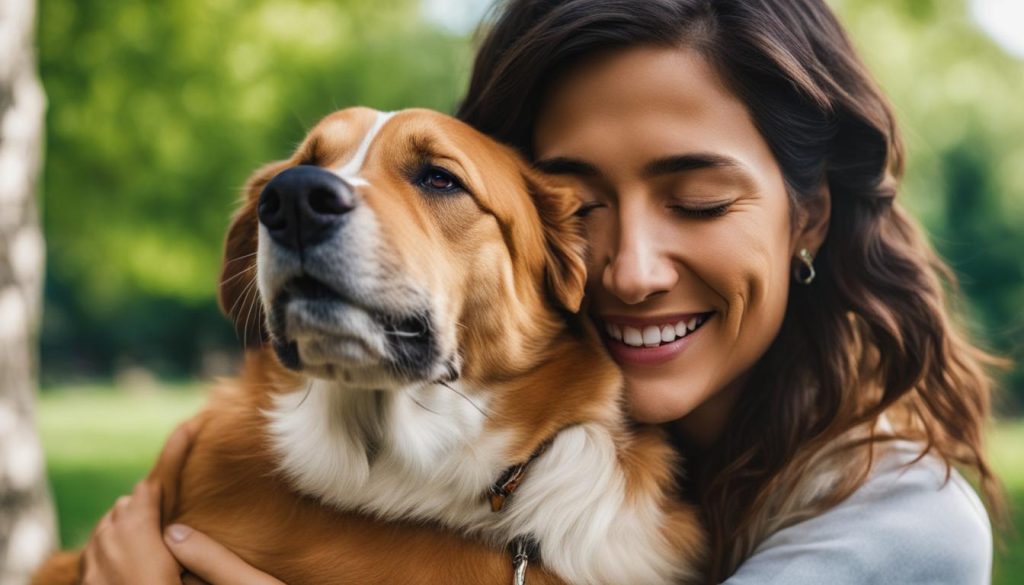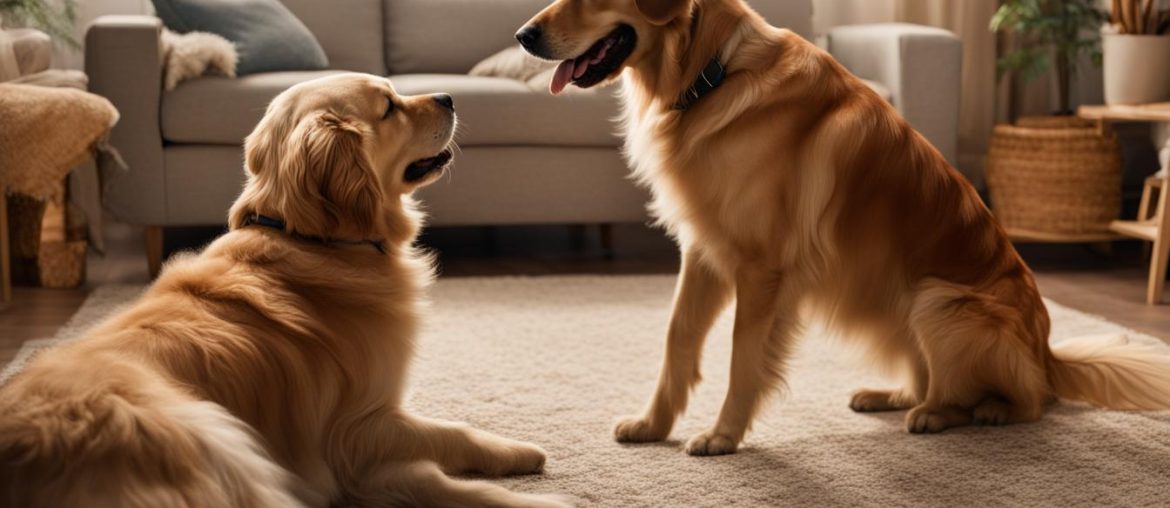Teaching your dog to hug can be a fun and rewarding experience. I recommend that you remember that not all dogs enjoy being hugged, so I would advise that you gauge your dog’s comfort level and willingness to participate. By using positive reinforcement and a step-by-step approach, you can teach your dog to hug on command, strengthening your bond and creating affectionate moments.
Key Takeaways:
- Teaching your dog to hug can strengthen your bond and create affectionate moments.
- Not all dogs enjoy being hugged, so respect your dog’s comfort level.
- Use positive reinforcement and a step-by-step approach to teach your dog to hug on command.
- Observe your dog’s body language and assess their comfort level with hugging.
- If your dog consistently shows signs of stress or discomfort, consider alternative bonding activities.
Importance of Hugging for Dogs and Owners
Building a strong bond with your dog is crucial for a harmonious and loving relationship. Hugging can play a significant role in strengthening this bond by creating moments of trust, affection, and happiness. While humans often find comfort in hugs, consider that hugging is not a natural behavior for dogs. Understanding your dog’s body language and comfort level is essential to ensure that hugging is a positive experience for both of you.
Hugging has been found to release endorphins, also known as “the happiness hormones,” in both dogs and humans. This hormonal release can promote a sense of well-being and strengthen the emotional connection between you and your furry friend. However, remember that not all dogs enjoy being hugged. Some dogs may perceive hugging as a sign of dominance or threat, leading to feelings of anxiety or discomfort.
Body Language: A Window into Your Dog’s Comfort
To determine if hugging is suitable for your dog, please observe their body language. Signs of comfort include relaxed ears, a soft expression, and a loose body posture. On the other hand, if your dog shows signs of stress, such as stiff body language, pinned-back ears, or avoiding eye contact, it’s necessary to respect their boundaries and find alternative ways to strengthen your bond.
| Signs of Comfort | Signs of Discomfort |
|---|---|
|
|
To put it simply, each dog is unique, and their comfort level may vary. You should also approach hugging with patience, respect, and understanding. If your dog does not enjoy being hugged, there are numerous other ways to build a strong bond, such as engaging in playtime, providing positive reinforcement training, or simply spending quality time together. The key is to prioritize your dog’s well-being and happiness in all interactions.
Types of Hugs You Can Teach Your Dog
When it comes to teaching your dog to hug, there are various types of hugs you can introduce depending on your dog’s size, physical abilities, and your personal preference. These different types of hugs can add variety and uniqueness to your training sessions, allowing you and your dog to find the perfect hug that suits both of you.
One popular type of hug is the head-on-shoulder hug. In this hug, your dog places their head on your shoulder, creating a heartwarming and affectionate embrace. This type of hug is great for smaller dogs, as it allows them to comfortably rest their head on your shoulder without too much strain.
Another option is the arms-on-shoulders hug. This hug involves your dog placing a paw on each of your shoulders, mimicking a human-like embrace. This type of hug works well for larger dogs who may have more strength and stability to support their weight on your shoulders.

Whichever type of hug you choose to teach your dog, use positive reinforcement and consistent training. Reward your dog with treats, praise, and affection whenever they successfully perform the hug command. Through patience and practice, your dog will learn to understand and execute these commands, strengthening your bond and creating heartwarming moments for both of you.
Steps to Teach Your Dog to Hug
Teaching your dog to hug can be a fun and rewarding experience that strengthens the bond between you and your furry friend. By following these steps and using positive reinforcement, you can successfully teach your dog to hug on command.
Step 1: Establish Basic Obedience Commands
Before you can teach your dog to hug, ensure they have a solid foundation of basic obedience commands. Start by teaching your dog commands such as sit, stay, and give a paw. These commands will lay the groundwork for learning more advanced tricks, like hugging.
Step 2: Introduce the Hug Command
Once your dog is comfortable with basic obedience commands, you can start introducing the hug command. Begin by luring your dog into a sitting position and then gently bring your arms around them to simulate a hug. Use a treat as a reward and give positive reinforcement when your dog remains calm and relaxed during the hug.
Repeat this step multiple times, gradually increasing the duration of the hug each time. Be sure to reward your dog with treats and praise for successful attempts. Consistency is key, so practice the hug command for a few minutes each day to reinforce the behavior.
Step 3: Reinforce the Hug Command
Once your dog understands the basic concept of the hug command, it’s time to reinforce the behavior. Practice hugging your dog in different locations and with distractions present to ensure they can perform the command in various situations. Try to reward your dog each time they successfully hug, reinforcing their positive behavior.
| Step | Description |
|---|---|
| Step 1 | Establish basic obedience commands |
| Step 2 | Introduce the hug command |
| Step 3 | Reinforce the hug command |
Teaching your dog to hug requires patience, consistency, and positive reinforcement. Try to always respect your dog’s comfort level, and never force them to engage in behavior they’re not comfortable with. With time and practice, you and your dog can enjoy the special bond that comes with sharing hugs.+

Assessing Your Dog’s Comfort Level with Hugging
When teaching your dog to hug, pay close attention to their comfort level and body language. Not all dogs enjoy being hugged, and forcing them into this behavior can cause stress and anxiety. By carefully assessing your dog’s responses, you can determine if hugging is a suitable activity for them.
Watch out for signs of discomfort such as lip licking, yawning, growling, or trying to back away. These behaviors indicate that your dog may not be comfortable with hugging. I highly suggest that you respect their boundaries and find alternative ways to strengthen your bond.
To put it simply, every dog is unique and may have different preferences when it comes to physical contact. Some dogs may enjoy other forms of affection, such as gentle pats, belly rubs, or playing together. You should also observe and understand your dog’s individual needs to create a positive and fulfilling relationship.
By prioritizing your dog’s well-being and understanding their comfort level, you can build trust and strengthen your bond in ways that both you and your furry friend will enjoy.

The Importance of Observing Body Language
Understanding your dog’s body language is crucial when assessing their comfort level with hugging. Here are some key indicators to look out for:
- Tail position: A tucked tail or a rapidly wagging tail can both indicate stress.
- Ear position: Pinned-back ears or ears held flat against the head may signal fear or discomfort.
- Eye contact: Avoidance of eye contact or wide-eyed expressions can suggest unease.
- Overall body posture: Stiffness, freezing, or leaning away from you are signs that your dog may not be receptive to hugging.
By familiarizing yourself with these body language cues and being attentive to your dog’s responses, you can ensure that their well-being and comfort are always prioritized.
To put it simply, the goal is to create a positive and loving relationship with your dog, and this can be achieved through a variety of activities that they enjoy and feel comfortable with.
Celebrating Hug Your Hound Day
Hug Your Hound Day is a special holiday that celebrates the bond between dogs and their owners. It falls on the second Sunday in September each year and serves as a reminder to show appreciation and affection for our furry friends. This day is an opportunity to engage in activities that promote trust, love, and understanding with our dogs.
On Hug Your Hound Day, take some time to reflect on the unique relationship you share with your canine companion. Consider their individual needs and preferences when it comes to physical contact and affection. While some dogs enjoy hugs and cuddles, others may feel uncomfortable or stressed by them. I highly suggest that you respect their boundaries and find alternative ways to strengthen your bond.
Hugging can be a symbol of love and affection for humans, but remember that it’s not a natural behavior for dogs. Each dog has their own unique personality and comfort level when it comes to physical contact. As responsible pet owners, it’s our duty to understand and respect their individual preferences.
Instead of hugging, you can engage in activities that dogs naturally enjoy, such as playing fetch, going for walks, or training sessions using positive reinforcement techniques. These activities not only strengthen the bond between you and your furry friend but also provide mental stimulation and physical exercise, which are essential for their overall well-being.

Hug Your Hound Day Activities
Here are some ideas for activities you can participate in on Hug Your Hound Day:
- Arrange a dog-friendly outing to a local park or beach
- Take your dog for a long, leisurely walk in a new neighborhood
- Plan a training session to learn new tricks and commands
- Organize a playdate with other friendly and well-socialized dogs
- Engage in interactive puzzle games that challenge their problem-solving skills
Try to always prioritize your dog’s comfort and well-being. If your dog shows signs of stress or discomfort during any activity, I would advise that you adjust accordingly and find alternative ways to bond and spend quality time together. Celebrating Hug Your Hound Day is about fostering a loving and trusting relationship with your dog, understanding their needs, and creating meaningful experiences that they enjoy.
Teaching Your Dog to Hug Another Dog
If you have multiple dogs and want to teach them to hug each other, ensure that both dogs are comfortable with close proximity and physical contact. Start with individual training sessions, teaching each dog to lay their paws on a surface or a toy. Gradually introduce the other dog into the training session, rewarding both dogs for their participation. Monitor their interactions closely and never force them to engage in any behavior they’re not comfortable with.
To facilitate the process, create a positive and relaxed environment during training sessions. Allow the dogs to sniff and greet each other before starting the training. Begin by teaching each dog to place their paws on a surface or object, using treats and positive reinforcement. Practice this command individually until both dogs are comfortable with the behavior.
| Dog | Behavior |
|---|---|
| Dog A | Place paws on surface |
| Dog B | Place paws on surface |
Once both dogs are consistently performing the behavior individually, introduce them to each other during training sessions. Start with short and controlled interactions, allowing the dogs to approach each other while keeping a close eye on their body language. Reward both dogs for calm and positive behavior during these initial interactions.
“Positive reinforcement is key when teaching dogs to interact with each other. Rewarding them for their desired behavior will help them associate the interaction with a positive experience.” – Professional Dog Trainer
Continue practicing the hug command with both dogs present, using treats and praise to reinforce the behavior. Gradually increase the duration and intensity of the hug, always monitoring both dogs’ comfort levels. If either dog shows signs of stress or discomfort, take a step back and ensure that they feel safe and secure before progressing further.
Troubleshooting Common Challenges
Teaching your dog to hug may come with some challenges along the way. Not all dogs will embrace this behavior, and please respect their preferences. If your dog shows signs of stress or avoids being hugged, it’s best to try alternative bonding activities or consult a professional behaviorist for guidance. Understanding your dog’s individual needs and limitations will contribute to a successful and enjoyable training experience.
One common challenge when teaching your dog to hug is their discomfort with close physical contact. Dogs are individuals with unique preferences, and some may not enjoy being hugged. I recommend that you recognize and respect your dog’s boundaries. If your dog shows signs of stress, such as pulling away, growling, or showing other signs of discomfort, it’s best to discontinue the training and find other ways to strengthen your bond.
Another challenge you may encounter is inconsistency in your dog’s response to the hug command. Dogs are sensitive to changes in environment and routine, so maintain a consistent training schedule. Frequent and short training sessions will help your dog understand and remember the command. Additionally, be patient and reinforce the command with treats and praise each time your dog successfully performs the hug. Consistency and positive reinforcement are key to overcoming this challenge.
Summary:
- Respect your dog’s preferences and comfort level when it comes to hugging.
- If your dog shows signs of stress or discomfort, consider alternative bonding activities.
- Consult a professional behaviorist for guidance if needed.
- Recognize and respect your dog’s individual boundaries.
- Maintain a consistent training schedule to overcome inconsistency in response.
- Use positive reinforcement, such as treats and praise, to reinforce the hug command.

Final Thoughts
To sum it up, teaching your dog to hug can be a rewarding and enjoyable experience that strengthens the bond between you and your furry friend. However, please always prioritize your dog’s comfort and well-being. Not all dogs enjoy hugging, so respect their individual preferences and boundaries.
By using positive reinforcement, patience, and understanding, you can create a loving and trusting relationship with your canine companion. Try to observe your dog’s body language and assess their comfort level throughout the training process.
If your dog shows signs of stress or avoids being hugged, it’s best to explore alternative ways to bond, such as through play and positive reinforcement training. Consulting a professional behaviorist can also provide valuable guidance tailored to your dog’s specific needs and limitations.
Ultimately, the key is to nurture a strong and affectionate connection with your dog based on mutual trust and respect. By focusing on their comfort and happiness, you can create a lifelong bond that will bring joy and fulfillment to both of you.
FAQ
Can all dogs be taught to hug?
Not all dogs enjoy being hugged, so gauge your dog’s comfort level and willingness to participate.
How can hugging benefit dogs and their owners?
Hugging can promote a stronger bond and release endorphins, or “happiness hormones,” for both dogs and their owners.
What types of hugs can I teach my dog?
You can teach your dog the head-on-shoulder hug or the arms-on-shoulders hug, depending on their size and physical abilities.
How can I teach my dog to hug?
Start with basic obedience training, gradually introduce the hug command, and use positive reinforcement and consistent training.
What should I do if my dog shows signs of stress when attempting to teach them to hug?
Respect their boundaries, consider alternative bonding activities, and consult a professional behaviorist for guidance if needed.
When is Hug Your Hound Day celebrated?
Hug Your Hound Day is celebrated on the second Sunday in September each year.
How can I teach my dog to hug another dog?
Start with individual training sessions, gradually introduce the other dog, and reward both dogs for their participation.
What should I do if my dog doesn’t seem to enjoy hugging?
Respect their preferences, try alternative bonding activities, and consult a professional behaviorist for guidance if needed.






